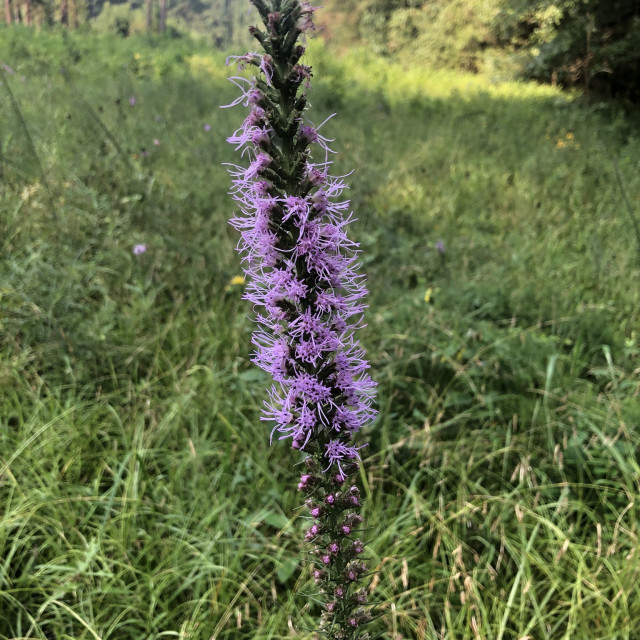COMMON NAME
Prairie blazing star
SCIENTIFIC NAME
Liatris pycnostachya
ALSO KNOWN AS
prairie gayfeather, cattail blazing star
Plant family
Aster (Asteraceae)
Plant group
Wildflowers and Herbs
Prairie blazing star is an herbaceous perennial plant native to Midwestern North America.
81 reports
31+
OBSERVERS
81+
OBSERVATIONS
Identification hints
The top two-thirds of a flowering prairie blazing star is a spike of rose-purple, thistle-like flowers that are given a somewhat fuzzy appearance by extended whitish purple stamens (male flower parts) and pistils (female flower parts). Flowering starts at the top of the spike and moves progressively downward. Each flower head along the spike is made up of 5 to 12 tubular florets. This species can be distinguished from other Liatris species by how many flower heads are attached around the flowering stem, giving it an almost "bottle-brush" appearance whereas other Liatris have sparser flower heads. The most similar other species is Liatris spicata, and in this case you can distinguish the two species by looking at the bracts that wrap around each flower head.
Did you know?
Prairie blazing star is an attractive plant to many pollinating insects including native solitary and ground nesting bees as well as monarch butterflies! They are also the host to the bleeding flower moth (Schinia sanguinea). Like other Liatris plants, this species root system is a corm which is a short tuber resembling a small potato.
DISTRIBUTION IN TH U.S.
Arkansas
,
Delaware
,
Iowa
,
Illinois
,
Indiana
,
Kansas
,
Kentucky
,
Louisiana
,
Massachusetts
,
Maine
,
Michigan
,
Minnesota
,
Missouri
,
Mississippi
,
North Dakota
,
Nebraska
,
New Jersey
,
New York
,
Ohio
,
Oklahoma
,
Pennsylvania
,
South Dakota
,
Texas
,
Wisconsin
HABITAT
Prairie blazing star prefers prairies and rocky, open areas including bluffs. They tolerate sun and moist to dry soil conditions, although it can tolerate moister conditions than most other Liatris species.
ATTRIBUTES
Leaves
"Pychnostachya" in the scientific name comes from the ancient greek for "crowded" or "dense" and equally refers to the leaves and the flower heads. Leaves are thus dense along the stem but are then and grasslike in appearance. Near the ground leaves can grow up to a foot long and 1/2 inch wide, but closer to the flowers leaves are much smaller, sometimes only an inch long and less than 1/8 of an inch wide.
Flowers
The flower heads of prairie blazing star are small, at about 1/3 inch in diameter, and contain 5-10 florets. Each floret produces one fruit that may or may not contain a seed. Florets are pinkish purple to lavender or occasionally white. Long anthers and styles protrude from the florets giving the appearance of the flowers having purple hairs coming out of them! The bracts, which wrap around each flower head and are visible particularly before flowering begins, are pinkish red, narrow at the tips, and curly, which distinguishes this species from others in the same genus.
Fruits
The fruits of prairie blazing star are small, dry, achenes, like miniature sunflower seeds that are narrower and shaped more like coriander seeds with a tuft of fluffy hair called a "pappus" on one end of the seed which helps it disperse in the wind.
Bloom Time
Prairie blazing star can bloom July through December depending on the state. In the northern part of the range, it starts flowering earlier and ends by late September, well before frost sets in.
See Menu
- 2021 Chicago Botanic Garden. All Rights Reserved.
-
Creative Commons
BY-NC-SA 4.0 - Terms of Use
- Privacy Policy
- Data Sharing and Citation Policies
- 2021 Chicago Botanic Garden. All Rights Reserved.



